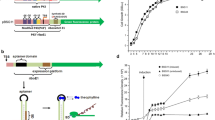Abstract
About 2% of the Bacillus subtilis genes are subject to regulation by riboswitch-controlled mechanisms. One of them is the l-lysine-dependent lysC gene which is turned on when the l-lysine concentration within the cytoplasm is low. In the presence of a high l-lysine concentration, only a 0.27-kb transcript is synthesized representing the riboswitch due to transcription termination. When the l-lysine concentration is low, the full-length 1.6-kb transcript is produced due to transcription anti-termination. Here, we show for the first time that even under conditions of transcription anti-termination the truncated form of the RNA is still predominant. This 0.27-kb transcript is neither the result of enhanced stability nor does it result from processing of the full-length transcript. When the region coding for the transcription terminator was removed, the riboswitch RNA failed to be produced. These data were confirmed by analysis of a transcriptional fusion between the promoter-riboswitch region of lysC with and without a functional transcriptional terminator and the lacZ reporter gene. The putative function(s) of the riboswitch under conditions of low l-lysine concentration is discussed.




Similar content being viewed by others
References
Chen NY, Hu FM, Paulus H (1987) Nucleotide sequence of the overlapping genes for the subunits of Bacillus subtilis aspartokinase II and their control regions. J Biol Chem 262:8787–8798
Gottesman S (2002) Stealth regulation: biological circuits with small RNA switches. Genes Dev 16:2829–2842
Grundy FJ, Lehman SC, Henkin TM (2003) The L box regulon: Lysine sensing by leader RNAs of bacterial lysine biosynthesis genes. Proc Natl Acad Sci USA 100:12057–12062
Henkin TM (2008) Riboswitch RNAs: using RNA to sense cellular metabolism. Genes Dev 22:3383–3390
Homuth G, Masuda S, Mogk A, Kobayashi Y, Schumann W (1997) The dnaK operon of Bacillus subtilis is heptacistronic. J Bacteriol 179:1153–1164
Kochhar S, Paulus H (1996) Lysine-induced premature transcription termination in the lysC operon of Bacillus subtilis. Microbiology 142:1635–1639
Lu Y, Chen NY, Paulus H (1991) Identification of aecA mutations in Bacillus subtilis as nucleotide substitutions in the untranslated leader region of the aspartokinase II operon. J Gen Microbiol 137:1135–1143
Lu Y, Shevtchenko TN, Paulus H (1992) Fine-structure mapping of cis-acting control sites in the lysC operon of Bacillus subtilis. FEMS Microbiol Lett 71:23–27
Mandal M, Lee M, Barrick JE, Weinberg Z, Emilsson GM, Ruzzo WL, Breaker RR (2004) A glycine-dependent riboswitch that uses cooperative binding to control gene expression. Science 306:275–279
Mogk A, Hayward R, Schumann W (1996) Integrative vectors for constructing single-copy transcriptional fusions between Bacillus subtilis promoters and various reporter genes encoding heat-stable enzymes. Gene 182:33–36
Saito H, Shibata T, Ando T (1979) Mapping of genes determining nonpermissiveness and host-specific restriction to bacteriophages in Bacillus subtilis Marburg. Mol Gen Genet 170:117–122
Spizizen J (1958) Transformation of biochemically deficient strains of Bacillus subtilis by deoxyribonucleate. Proc Natl Acad Sci USA 44:407–408
Storz G, Opdyke JA, Zhang A (2004) Controlling mRNA stability and translation with small, noncoding RNAs. Curr Opin Microbiol 7:140–144
Sudarsan N, Wickiser JK, Nakamura S, Ebert MS, Breaker RR (2003) An mRNA structure in bacteria that controls gene expression by binding lysine. Genes Dev 17:2688–2697
Tucker BJ, Breaker RR (2005) Riboswitches as versatile gene control elements. Curr Opin Struct Biol 15:342–348
Winkler WC (2005) Metabolic monitoring by bacterial mRNAs. Arch Microbiol 183:151–159
Winkler WC, Breaker RR (2005) Regulation of bacterial gene expression by riboswitches. Annu Rev Microbiol 59:487–517
Yeh EC, Steinberg W (1978) The effect of gene position, gene dosage and a regulatory mutation on the temporal sequence of enzyme synthesis accompanying outgrowth of Bacillus subtilis spores. Mol Gen Genet 158:287–296
Acknowledgement
We thank the Bayerische Forschungsstiftung for financial support.
Author information
Authors and Affiliations
Corresponding author
Rights and permissions
About this article
Cite this article
Phan, T.T.P., Schumann, W. Transcriptional Analysis of the Lysine-Responsive and Riboswitch-Regulated lysC Gene of Bacillus subtilis . Curr Microbiol 59, 463–468 (2009). https://doi.org/10.1007/s00284-009-9461-4
Received:
Accepted:
Published:
Issue Date:
DOI: https://doi.org/10.1007/s00284-009-9461-4




